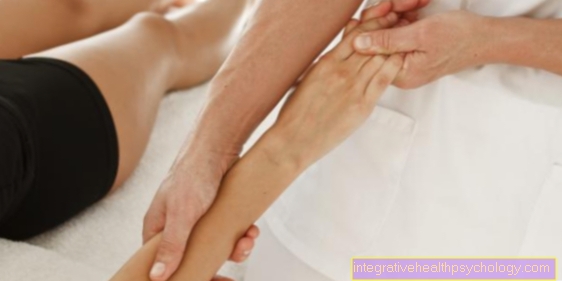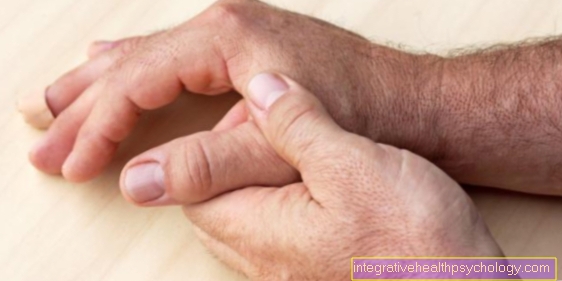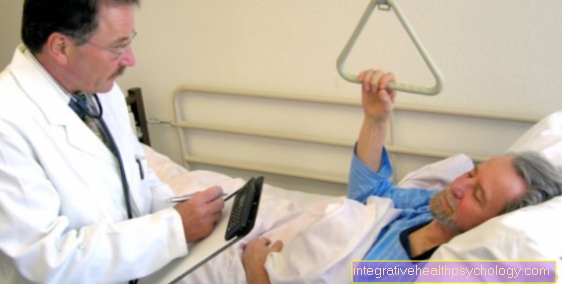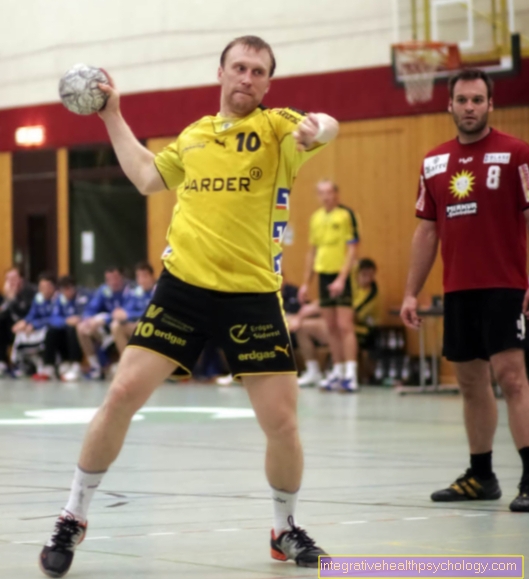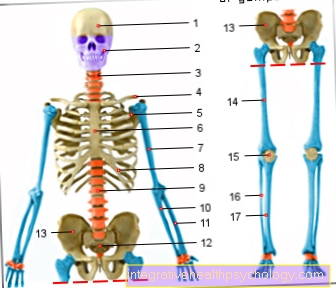Triangular disc
What is the triangular disc?
The triangular disc is a disc of cartilage that is embedded between the first row of the carpal bones and the ulna and radius. It ensures that forces acting on the wrist can be better cushioned and also prevents the ulna, radius and carpal bone from rubbing directly against each other.

anatomy
Looking from above onto the back of the hand, the triangular disc is located in the area of the outer wrist (on the side of the little finger), between the ulna and the first row of the carpal bones. In addition, a small portion of it shines into the gap between ulna and radius. The designation triangularis comes from its triangular shape. The location describes the synonym "Discus ulnocarpalis" better.
The triangular disc is attached to the lower edge of the radius pointing towards the ulna and extends from there to the outer edge of the ulna, where it together with the Meniscus ulnocarpalis fills the joint space between the carpal bone and ulna. The disc is also secured upwards, downwards and outwards with straps that run from the ulna and radius to the carpal bones and thus secure the disc in its position.
Find out more about the topic here: wrist
Function of the triangular disc
The function of the triangular disc can roughly be compared to that of an intervertebral disc. Since it consists of firm, yet elastic cartilage, it serves as a kind of shock absorber. Supporting movements that we undertake with our palms would be transmitted unhindered from the hand to the forearm bones - the radius and especially the ulna - without this cartilage disc. Direct bone contact would make this very uncomfortable to painful and would lead to fractures in the forearm bones much more easily.
In addition, the triangular disc serves to improve the mobility of the ulna and carpal bones, as well as of ulna and radius relative to one another. So it also fulfills a plain bearing function.
Rupture of the triangular disc
The triangular disc tears usually as a result of an accident involving the wrist. Another possibility is the degenerative change of the disc. Excessive stress on the cartilage disc leads to weakness and consequently to a tear. The standard examination to establish a diagnosis is either MRI as a non-invasive method or a jointoscopy (Athroscopy), in which a small camera is pushed through a few millimeters incision in the wrist in order to check the nature of the discus.
A distinction must be made between the severity of the tear, which is also used for the treatment. In mild cases, the roughened surface of the triangular disc is merely smoothed, whereas in the case of small tears, part of the disc can be removed and in the case of severe tears, the cartilage disc is sutured.
Nowadays, therapy is almost exclusively athroscopic, i.e. only with the help of two small instruments in the otherwise closed joint cavity and only in exceptional cases on the fully opened wrist. The anesthesia is usually done locally, so that one is conscious during the operation, but the pain sensation in the affected area is switched off.
Read more about the topic here: Arthroscopy of the wrist
Lesion of the TFCC
The TFCC is the so-called triangular fibrocartilaginous complex, i.e. the triangular triangular disc and the ligaments that fix it in the area of the wrist on the side of the little finger.
Lesions can arise here either as a result of abrupt force in the form of a fall, blows or support from the falling movement, or as a result of wear and tear after prolonged incorrect loading or an ulna that is too long compared to the spoke.
The diagnosis is made on the one hand from the symptoms described: Typically there are pain when rotating the wrist and on the other hand using an MRI examination or an athroscopy of the wrist.
The care of the injury depends on its severity. From treatment with painkillers for mild degenerative pain to suturing a tear in the triangular disc or a limiting ligament, treatment is tailored to the needs of the patient. After the operation, the joint is usually immobilized for several weeks and then slowly brought back to the old stressful situation in everyday life with the help of physiotherapy.


